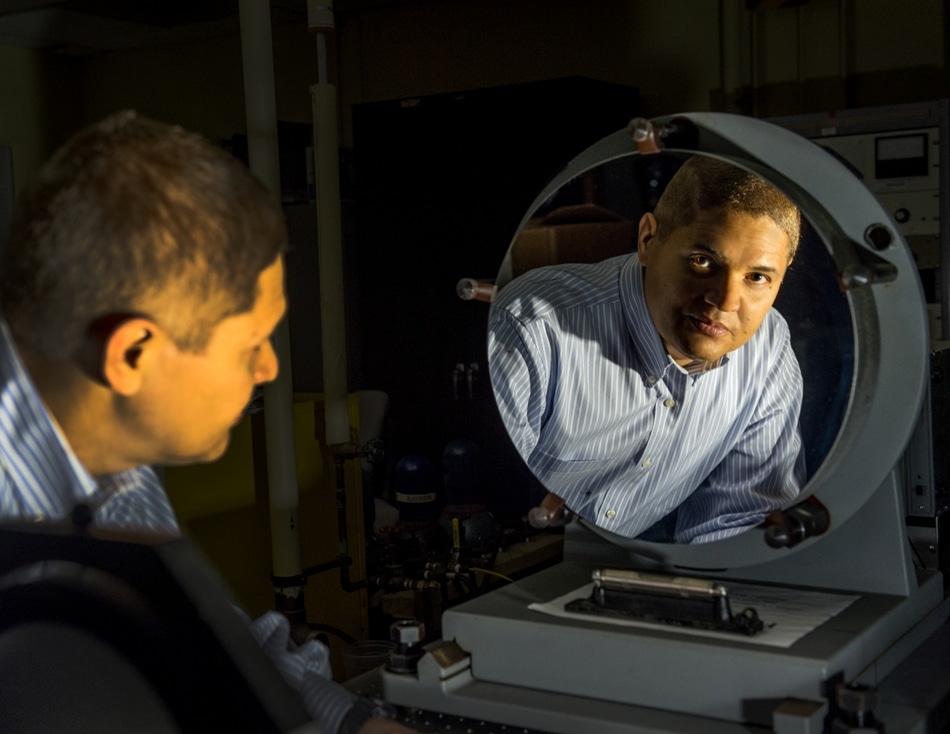May 31 2017
Scientists at NASA have produced telescope mirrors that have the highest ever reflectance observed in the far-ultraviolet spectral range. Now, they are attempting to set another record.
 Principal Investigator Manuel Quijada is shown here with the type of optic he and his team would coat with a fluoride film to provide maximum reflectance over a wide spectral range. Credit: NASA/W.Hrybyk.
Principal Investigator Manuel Quijada is shown here with the type of optic he and his team would coat with a fluoride film to provide maximum reflectance over a wide spectral range. Credit: NASA/W.Hrybyk.
Manuel Quijada and his colleagues—who are Optical Experts at NASA’s Goddard Space Flight Center in Greenbelt, Maryland—are exploring methods to create highly reflective aluminum mirrors that are sensitive to the infrared, optical and far-ultraviolet wavelength ranges, which is a wide spectral range visualized for proposed space telescopes as a sequel to the Wide Field Infrared Survey Telescope and the James Webb Space Telescope. The proposed assignment will have the ability to address a wide range of Astrophysics research works ranging from the age of reionization, through the formation of galaxy and its evolution, to the formation of stars and planets.
Quijada and his colleagues are particularly investigating three different materials and methods for developing and applying protective layers on aluminum mirrors to avoid oxidization upon exposure to oxygen and to prevent the mirrors from losing their reflectivity.
Aluminum is a metal that nature has given us the broadest spectral coverage. However, aluminum needs to be protected from naturally occurring oxides with a thin film or substrate of transparent material.
Manuel Quijada, Optical Expert, NASA Goddard Space Flight Center, Maryland
Unfortunately, no one has developed a coating that effectively protects and maintains a mirror's high reflectivity in the 90 to 130 nm range, also known as the Lyman Alpha range. In this spectral range, Researchers can notice a rich array of spectral lines and astronomical targets including potentially habitable planets beyond our solar system.
The low reflectivity of coatings in this range is one of the biggest constraints in far-ultraviolet telescope and spectrograph design.
Manuel Quijada, Optical Expert, NASA Goddard Space Flight Center, Maryland
Wavelength of ultraviolet light is shorter than that of visible light but longer than that of X-rays, and is not visible to the naked eye. We can observe objects in this wavelength only if the instruments are tuned to the wavelength.
A recent assignment from NASA completely devoted to far-ultraviolet observations was the Far Ultraviolet Spectroscopic Explorer (FUSE). Following a successful primary mission, it was decommissioned in the year 2007. According to Quijada, even when FUSE obtained 6000 observations of almost 3000 seperate astronomical objects when it was in orbit for a period of 8 years, its lithium fluoride substrate coating was not adequately stable and started to degrade over time.
Quijada aims to synthesize a coating as well as a process that—apart from enhancing reflectance in the far ultraviolet—enables observations in other wavelength bands as well.
Traditional coating processes have not allowed the use of aluminum mirrors to their full potential. The new coatings we’re investigating would enable a telescope covering a very broad spectral range, from the far ultraviolet to the near-infrared in one single observatory. NASA would get more bang for the buck.
Manuel Quijada, Optical Expert, NASA Goddard Space Flight Center, Maryland
Under one coating approach, the Researchers used physical vapor deposition to apply a thin xenon difluoride gas layer onto an aluminum sample. Research works have demonstrated that the treatment of xenon difluoride generates fluorine ions that get firmly bound to the aluminum surface, thus arresting further oxidation, Quijada said.
In order to apply thin films of aluminum trifluoride, Quijada is also analyzing the use of two other thin-film deposition methods, namely, atomic layer deposition and ion-assisted physical vapor deposition. When compared to other coatings, aluminum trifluoride is environmentally stable.
Quijada and his colleagues have already been successful in synthesizing a coating for another region in the ultraviolet spectral band.
In the year 2016, a validation test demonstrated that a protective coating developed by the Research team produced 90% reflectance in the 133.6 to 154.5 nm range, which is the highest reflectance observed ever in the ultraviolet band. In order to accomplish this unparalleled performance, the Researchers created a three-step physical vapor deposition procedure for coating aluminum mirrors with protective lithium fluoride or magnesium fluoride films.
Quijada stated that such high-reflectance coatings are at present powering innovative types of instruments. Two new heliophysics missions, namely, the Global-scale Observations of the Limb and Disk and the Ionospheric Connection Explorer that will analyze the interactions between solar winds and Earth’s ionosphere, will use this coating technique.
“We need to push further down in the ultraviolet spectrum,” stated Quijada, regarding the targeted far-ultraviolet spectral range. “We need to get access to the whole ultraviolet to infrared range. We are blazing a trail in mirror coatings.”